Health Service Plan: Analyzing the Impact of a Sugar Tax Policy
VerifiedAdded on 2022/11/13
|9
|2996
|91
Report
AI Summary
This report presents a health service plan focused on implementing a sugar tax to reduce sugar consumption and address associated health issues. It begins by introducing the concept of sugar tax and its relevance to public health, highlighting the alarming rates of added sugar consumption and related health complications. The plan aims to reduce sugar intake to levels recommended by the WHO through various objectives, including improved labeling, public awareness campaigns, and online resources. A stakeholder analysis identifies key players like the government, food companies, consumers, and health agencies, assessing their power and interests. A needs assessment reveals consumer preferences and the importance of clear information. A SWOT analysis identifies the strengths, weaknesses, opportunities, and threats associated with the policy. The report prioritizes raising public awareness and education over immediate taxation, emphasizing the importance of informed consumer choices and addressing the underlying factors driving sugar consumption.
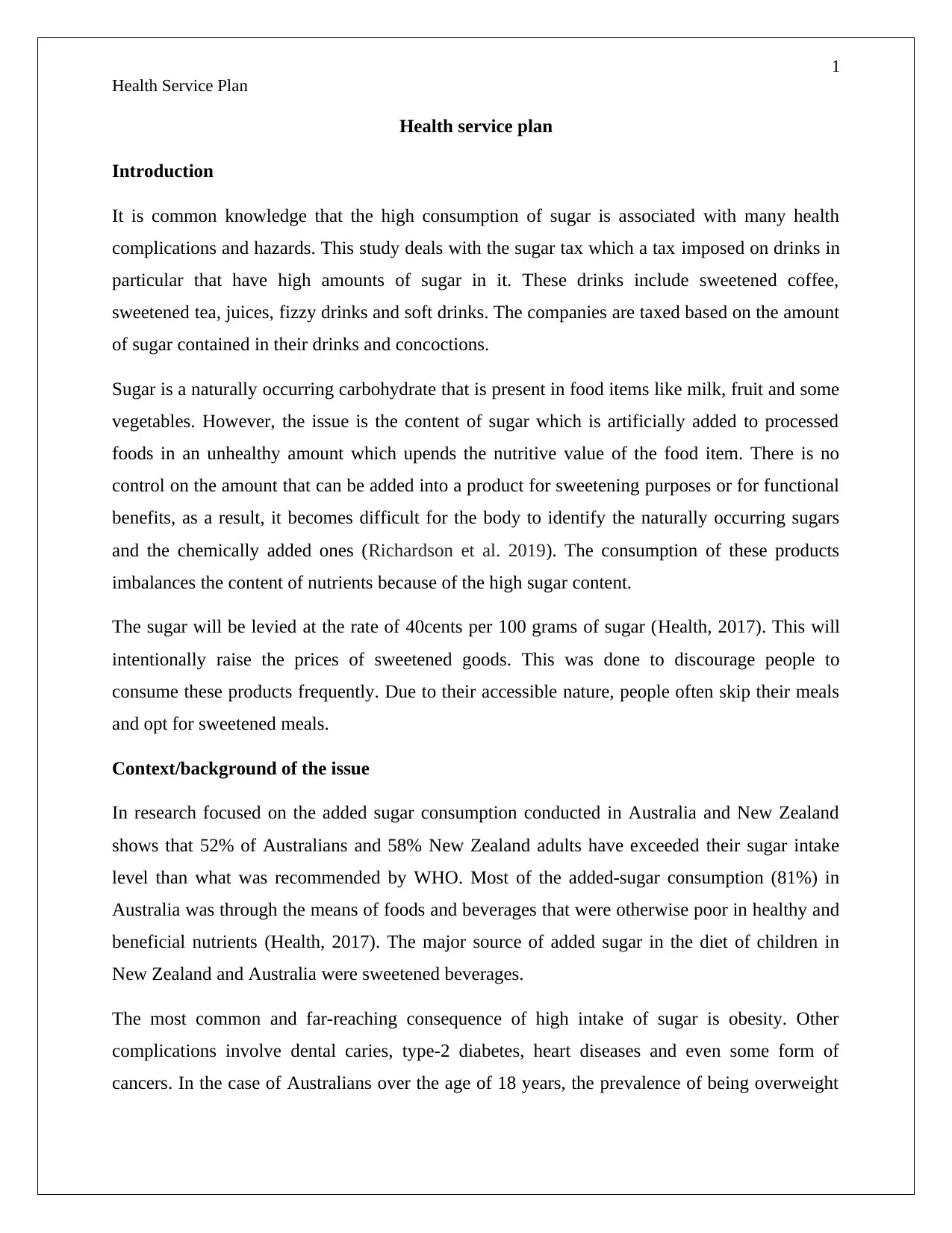
1
Health Service Plan
Health service plan
Introduction
It is common knowledge that the high consumption of sugar is associated with many health
complications and hazards. This study deals with the sugar tax which a tax imposed on drinks in
particular that have high amounts of sugar in it. These drinks include sweetened coffee,
sweetened tea, juices, fizzy drinks and soft drinks. The companies are taxed based on the amount
of sugar contained in their drinks and concoctions.
Sugar is a naturally occurring carbohydrate that is present in food items like milk, fruit and some
vegetables. However, the issue is the content of sugar which is artificially added to processed
foods in an unhealthy amount which upends the nutritive value of the food item. There is no
control on the amount that can be added into a product for sweetening purposes or for functional
benefits, as a result, it becomes difficult for the body to identify the naturally occurring sugars
and the chemically added ones (Richardson et al. 2019). The consumption of these products
imbalances the content of nutrients because of the high sugar content.
The sugar will be levied at the rate of 40cents per 100 grams of sugar (Health, 2017). This will
intentionally raise the prices of sweetened goods. This was done to discourage people to
consume these products frequently. Due to their accessible nature, people often skip their meals
and opt for sweetened meals.
Context/background of the issue
In research focused on the added sugar consumption conducted in Australia and New Zealand
shows that 52% of Australians and 58% New Zealand adults have exceeded their sugar intake
level than what was recommended by WHO. Most of the added-sugar consumption (81%) in
Australia was through the means of foods and beverages that were otherwise poor in healthy and
beneficial nutrients (Health, 2017). The major source of added sugar in the diet of children in
New Zealand and Australia were sweetened beverages.
The most common and far-reaching consequence of high intake of sugar is obesity. Other
complications involve dental caries, type-2 diabetes, heart diseases and even some form of
cancers. In the case of Australians over the age of 18 years, the prevalence of being overweight
Health Service Plan
Health service plan
Introduction
It is common knowledge that the high consumption of sugar is associated with many health
complications and hazards. This study deals with the sugar tax which a tax imposed on drinks in
particular that have high amounts of sugar in it. These drinks include sweetened coffee,
sweetened tea, juices, fizzy drinks and soft drinks. The companies are taxed based on the amount
of sugar contained in their drinks and concoctions.
Sugar is a naturally occurring carbohydrate that is present in food items like milk, fruit and some
vegetables. However, the issue is the content of sugar which is artificially added to processed
foods in an unhealthy amount which upends the nutritive value of the food item. There is no
control on the amount that can be added into a product for sweetening purposes or for functional
benefits, as a result, it becomes difficult for the body to identify the naturally occurring sugars
and the chemically added ones (Richardson et al. 2019). The consumption of these products
imbalances the content of nutrients because of the high sugar content.
The sugar will be levied at the rate of 40cents per 100 grams of sugar (Health, 2017). This will
intentionally raise the prices of sweetened goods. This was done to discourage people to
consume these products frequently. Due to their accessible nature, people often skip their meals
and opt for sweetened meals.
Context/background of the issue
In research focused on the added sugar consumption conducted in Australia and New Zealand
shows that 52% of Australians and 58% New Zealand adults have exceeded their sugar intake
level than what was recommended by WHO. Most of the added-sugar consumption (81%) in
Australia was through the means of foods and beverages that were otherwise poor in healthy and
beneficial nutrients (Health, 2017). The major source of added sugar in the diet of children in
New Zealand and Australia were sweetened beverages.
The most common and far-reaching consequence of high intake of sugar is obesity. Other
complications involve dental caries, type-2 diabetes, heart diseases and even some form of
cancers. In the case of Australians over the age of 18 years, the prevalence of being overweight
Paraphrase This Document
Need a fresh take? Get an instant paraphrase of this document with our AI Paraphraser
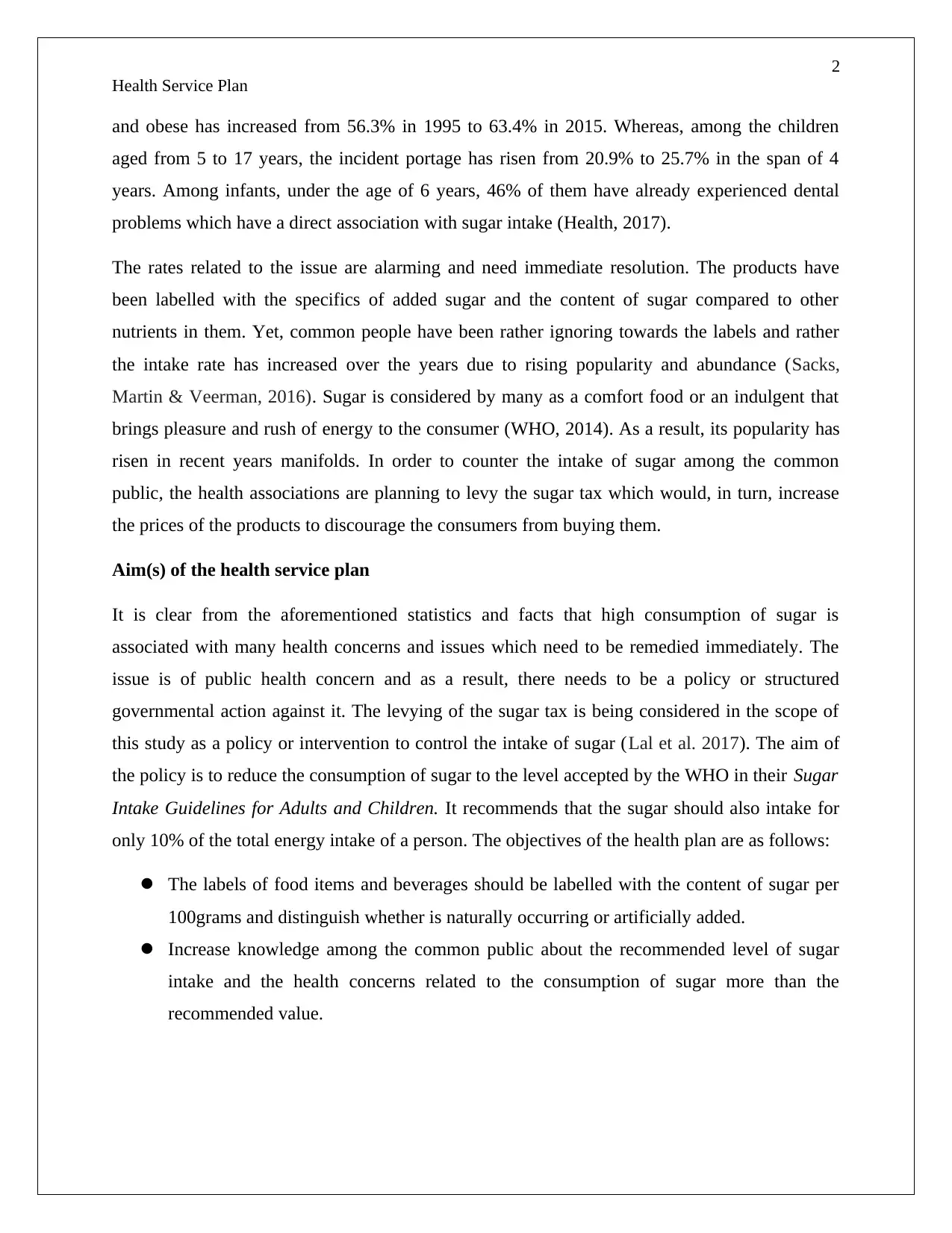
2
Health Service Plan
and obese has increased from 56.3% in 1995 to 63.4% in 2015. Whereas, among the children
aged from 5 to 17 years, the incident portage has risen from 20.9% to 25.7% in the span of 4
years. Among infants, under the age of 6 years, 46% of them have already experienced dental
problems which have a direct association with sugar intake (Health, 2017).
The rates related to the issue are alarming and need immediate resolution. The products have
been labelled with the specifics of added sugar and the content of sugar compared to other
nutrients in them. Yet, common people have been rather ignoring towards the labels and rather
the intake rate has increased over the years due to rising popularity and abundance (Sacks,
Martin & Veerman, 2016). Sugar is considered by many as a comfort food or an indulgent that
brings pleasure and rush of energy to the consumer (WHO, 2014). As a result, its popularity has
risen in recent years manifolds. In order to counter the intake of sugar among the common
public, the health associations are planning to levy the sugar tax which would, in turn, increase
the prices of the products to discourage the consumers from buying them.
Aim(s) of the health service plan
It is clear from the aforementioned statistics and facts that high consumption of sugar is
associated with many health concerns and issues which need to be remedied immediately. The
issue is of public health concern and as a result, there needs to be a policy or structured
governmental action against it. The levying of the sugar tax is being considered in the scope of
this study as a policy or intervention to control the intake of sugar (Lal et al. 2017). The aim of
the policy is to reduce the consumption of sugar to the level accepted by the WHO in their Sugar
Intake Guidelines for Adults and Children. It recommends that the sugar should also intake for
only 10% of the total energy intake of a person. The objectives of the health plan are as follows:
The labels of food items and beverages should be labelled with the content of sugar per
100grams and distinguish whether is naturally occurring or artificially added.
Increase knowledge among the common public about the recommended level of sugar
intake and the health concerns related to the consumption of sugar more than the
recommended value.
Health Service Plan
and obese has increased from 56.3% in 1995 to 63.4% in 2015. Whereas, among the children
aged from 5 to 17 years, the incident portage has risen from 20.9% to 25.7% in the span of 4
years. Among infants, under the age of 6 years, 46% of them have already experienced dental
problems which have a direct association with sugar intake (Health, 2017).
The rates related to the issue are alarming and need immediate resolution. The products have
been labelled with the specifics of added sugar and the content of sugar compared to other
nutrients in them. Yet, common people have been rather ignoring towards the labels and rather
the intake rate has increased over the years due to rising popularity and abundance (Sacks,
Martin & Veerman, 2016). Sugar is considered by many as a comfort food or an indulgent that
brings pleasure and rush of energy to the consumer (WHO, 2014). As a result, its popularity has
risen in recent years manifolds. In order to counter the intake of sugar among the common
public, the health associations are planning to levy the sugar tax which would, in turn, increase
the prices of the products to discourage the consumers from buying them.
Aim(s) of the health service plan
It is clear from the aforementioned statistics and facts that high consumption of sugar is
associated with many health concerns and issues which need to be remedied immediately. The
issue is of public health concern and as a result, there needs to be a policy or structured
governmental action against it. The levying of the sugar tax is being considered in the scope of
this study as a policy or intervention to control the intake of sugar (Lal et al. 2017). The aim of
the policy is to reduce the consumption of sugar to the level accepted by the WHO in their Sugar
Intake Guidelines for Adults and Children. It recommends that the sugar should also intake for
only 10% of the total energy intake of a person. The objectives of the health plan are as follows:
The labels of food items and beverages should be labelled with the content of sugar per
100grams and distinguish whether is naturally occurring or artificially added.
Increase knowledge among the common public about the recommended level of sugar
intake and the health concerns related to the consumption of sugar more than the
recommended value.
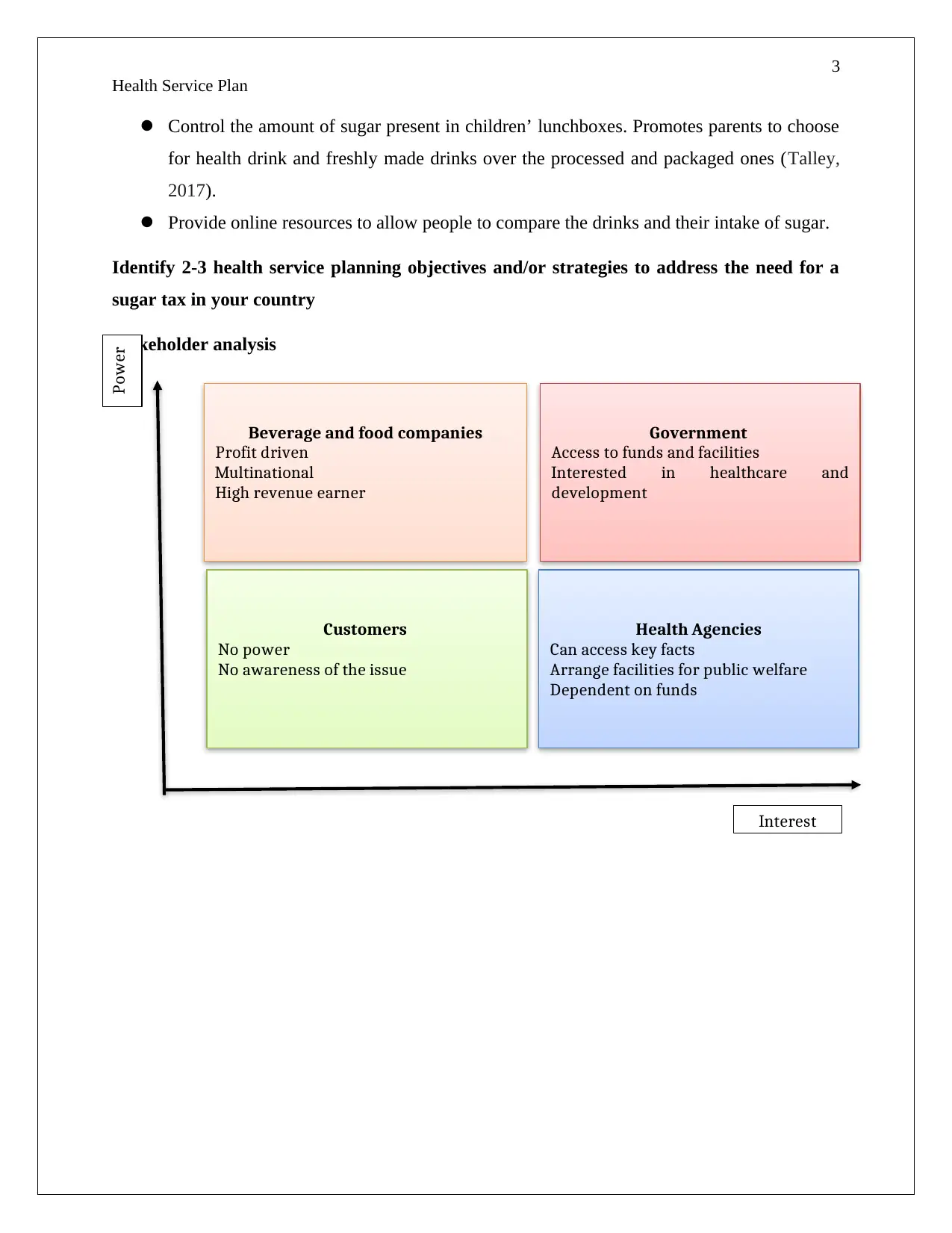
3
Health Service Plan
Control the amount of sugar present in children’ lunchboxes. Promotes parents to choose
for health drink and freshly made drinks over the processed and packaged ones (Talley,
2017).
Provide online resources to allow people to compare the drinks and their intake of sugar.
Identify 2-3 health service planning objectives and/or strategies to address the need for a
sugar tax in your country
Stakeholder analysis
Customers
No power
No awareness of the issue
Health Agencies
Can access key facts
Arrange facilities for public welfare
Dependent on funds
Beverage and food companies
Profit driven
Multinational
High revenue earner
Government
Access to funds and facilities
Interested in healthcare and
development
Interest
Power
Health Service Plan
Control the amount of sugar present in children’ lunchboxes. Promotes parents to choose
for health drink and freshly made drinks over the processed and packaged ones (Talley,
2017).
Provide online resources to allow people to compare the drinks and their intake of sugar.
Identify 2-3 health service planning objectives and/or strategies to address the need for a
sugar tax in your country
Stakeholder analysis
Customers
No power
No awareness of the issue
Health Agencies
Can access key facts
Arrange facilities for public welfare
Dependent on funds
Beverage and food companies
Profit driven
Multinational
High revenue earner
Government
Access to funds and facilities
Interested in healthcare and
development
Interest
Power
⊘ This is a preview!⊘
Do you want full access?
Subscribe today to unlock all pages.

Trusted by 1+ million students worldwide
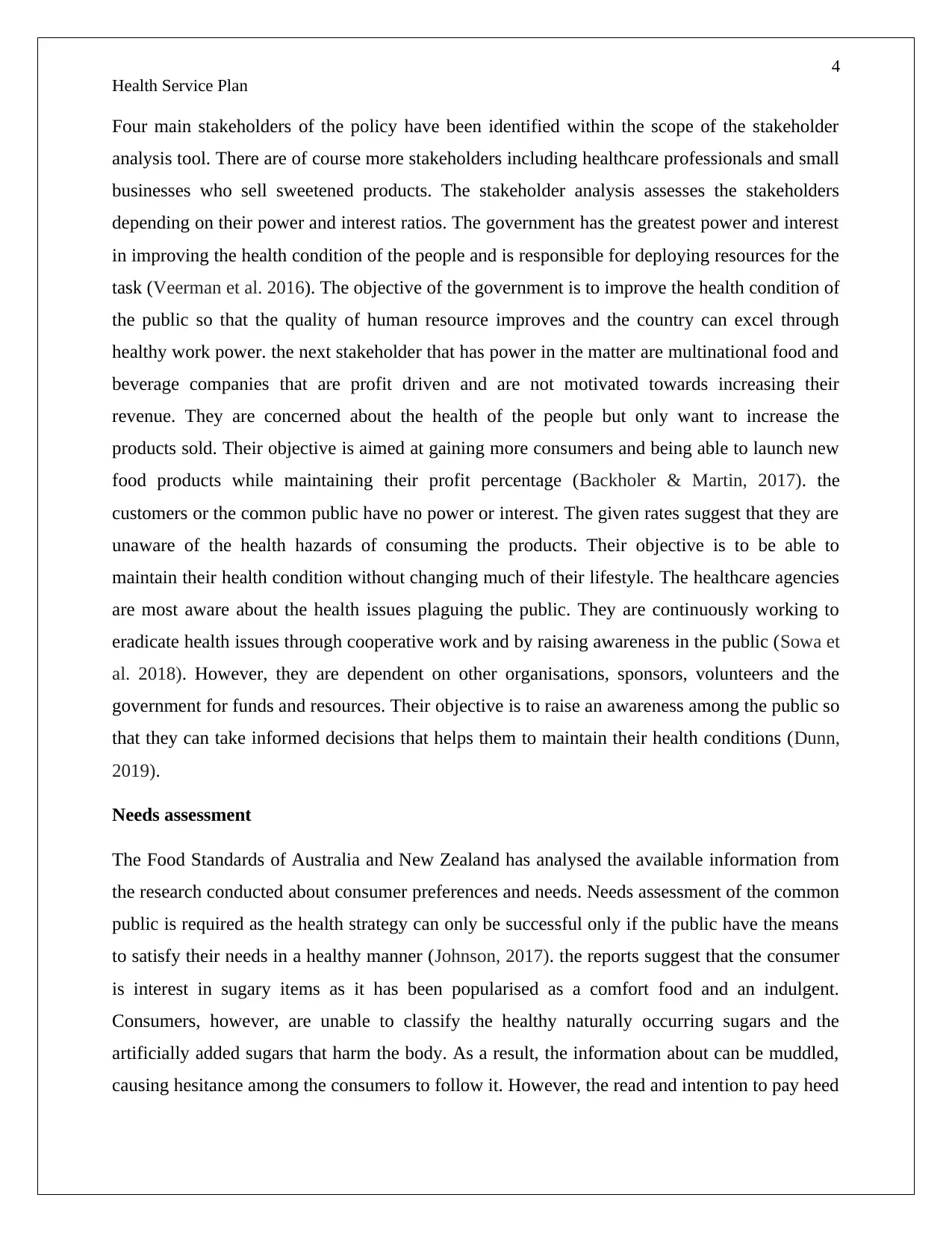
4
Health Service Plan
Four main stakeholders of the policy have been identified within the scope of the stakeholder
analysis tool. There are of course more stakeholders including healthcare professionals and small
businesses who sell sweetened products. The stakeholder analysis assesses the stakeholders
depending on their power and interest ratios. The government has the greatest power and interest
in improving the health condition of the people and is responsible for deploying resources for the
task (Veerman et al. 2016). The objective of the government is to improve the health condition of
the public so that the quality of human resource improves and the country can excel through
healthy work power. the next stakeholder that has power in the matter are multinational food and
beverage companies that are profit driven and are not motivated towards increasing their
revenue. They are concerned about the health of the people but only want to increase the
products sold. Their objective is aimed at gaining more consumers and being able to launch new
food products while maintaining their profit percentage (Backholer & Martin, 2017). the
customers or the common public have no power or interest. The given rates suggest that they are
unaware of the health hazards of consuming the products. Their objective is to be able to
maintain their health condition without changing much of their lifestyle. The healthcare agencies
are most aware about the health issues plaguing the public. They are continuously working to
eradicate health issues through cooperative work and by raising awareness in the public (Sowa et
al. 2018). However, they are dependent on other organisations, sponsors, volunteers and the
government for funds and resources. Their objective is to raise an awareness among the public so
that they can take informed decisions that helps them to maintain their health conditions (Dunn,
2019).
Needs assessment
The Food Standards of Australia and New Zealand has analysed the available information from
the research conducted about consumer preferences and needs. Needs assessment of the common
public is required as the health strategy can only be successful only if the public have the means
to satisfy their needs in a healthy manner (Johnson, 2017). the reports suggest that the consumer
is interest in sugary items as it has been popularised as a comfort food and an indulgent.
Consumers, however, are unable to classify the healthy naturally occurring sugars and the
artificially added sugars that harm the body. As a result, the information about can be muddled,
causing hesitance among the consumers to follow it. However, the read and intention to pay heed
Health Service Plan
Four main stakeholders of the policy have been identified within the scope of the stakeholder
analysis tool. There are of course more stakeholders including healthcare professionals and small
businesses who sell sweetened products. The stakeholder analysis assesses the stakeholders
depending on their power and interest ratios. The government has the greatest power and interest
in improving the health condition of the people and is responsible for deploying resources for the
task (Veerman et al. 2016). The objective of the government is to improve the health condition of
the public so that the quality of human resource improves and the country can excel through
healthy work power. the next stakeholder that has power in the matter are multinational food and
beverage companies that are profit driven and are not motivated towards increasing their
revenue. They are concerned about the health of the people but only want to increase the
products sold. Their objective is aimed at gaining more consumers and being able to launch new
food products while maintaining their profit percentage (Backholer & Martin, 2017). the
customers or the common public have no power or interest. The given rates suggest that they are
unaware of the health hazards of consuming the products. Their objective is to be able to
maintain their health condition without changing much of their lifestyle. The healthcare agencies
are most aware about the health issues plaguing the public. They are continuously working to
eradicate health issues through cooperative work and by raising awareness in the public (Sowa et
al. 2018). However, they are dependent on other organisations, sponsors, volunteers and the
government for funds and resources. Their objective is to raise an awareness among the public so
that they can take informed decisions that helps them to maintain their health conditions (Dunn,
2019).
Needs assessment
The Food Standards of Australia and New Zealand has analysed the available information from
the research conducted about consumer preferences and needs. Needs assessment of the common
public is required as the health strategy can only be successful only if the public have the means
to satisfy their needs in a healthy manner (Johnson, 2017). the reports suggest that the consumer
is interest in sugary items as it has been popularised as a comfort food and an indulgent.
Consumers, however, are unable to classify the healthy naturally occurring sugars and the
artificially added sugars that harm the body. As a result, the information about can be muddled,
causing hesitance among the consumers to follow it. However, the read and intention to pay heed
Paraphrase This Document
Need a fresh take? Get an instant paraphrase of this document with our AI Paraphraser
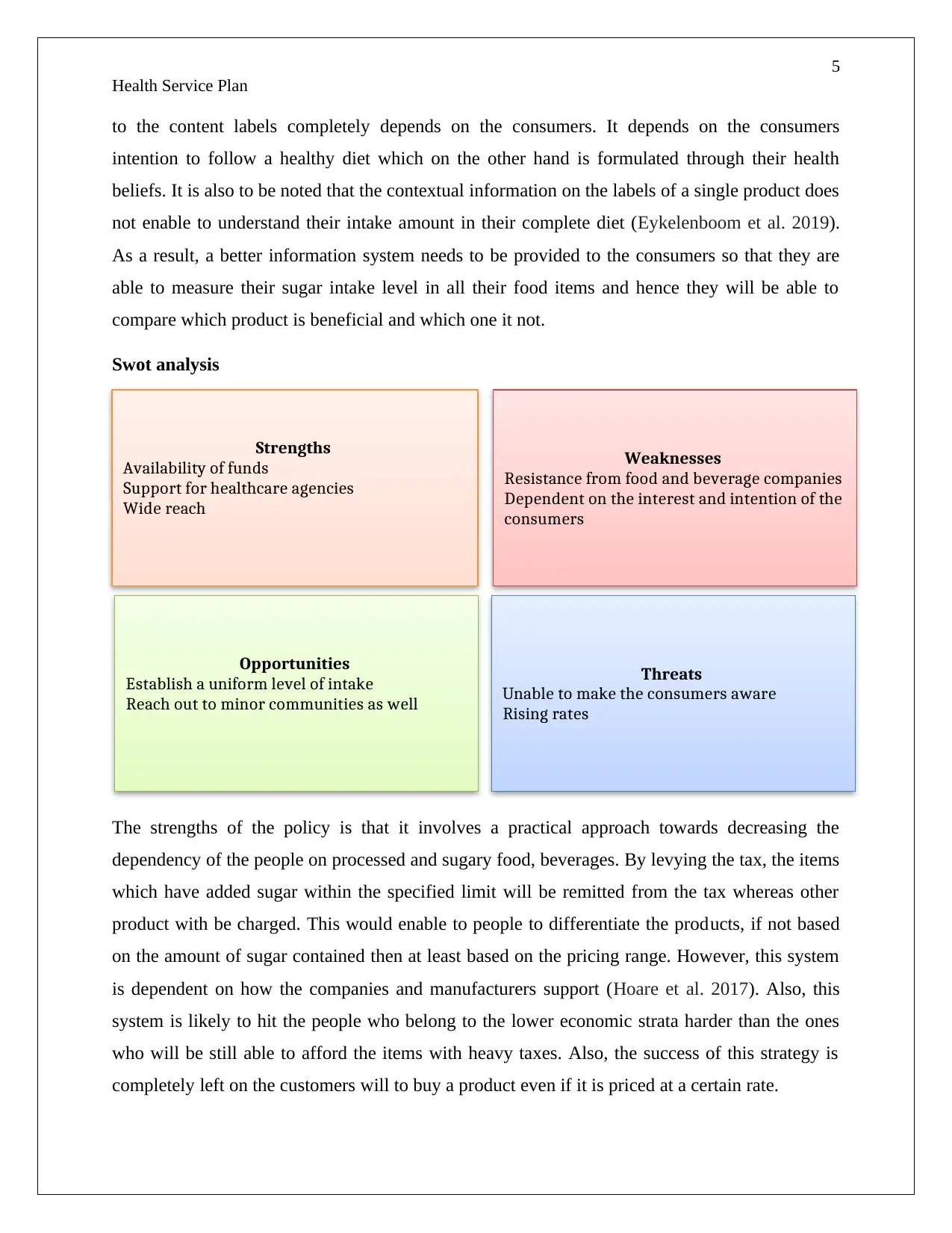
5
Health Service Plan
to the content labels completely depends on the consumers. It depends on the consumers
intention to follow a healthy diet which on the other hand is formulated through their health
beliefs. It is also to be noted that the contextual information on the labels of a single product does
not enable to understand their intake amount in their complete diet (Eykelenboom et al. 2019).
As a result, a better information system needs to be provided to the consumers so that they are
able to measure their sugar intake level in all their food items and hence they will be able to
compare which product is beneficial and which one it not.
Swot analysis
The strengths of the policy is that it involves a practical approach towards decreasing the
dependency of the people on processed and sugary food, beverages. By levying the tax, the items
which have added sugar within the specified limit will be remitted from the tax whereas other
product with be charged. This would enable to people to differentiate the products, if not based
on the amount of sugar contained then at least based on the pricing range. However, this system
is dependent on how the companies and manufacturers support (Hoare et al. 2017). Also, this
system is likely to hit the people who belong to the lower economic strata harder than the ones
who will be still able to afford the items with heavy taxes. Also, the success of this strategy is
completely left on the customers will to buy a product even if it is priced at a certain rate.
Opportunities
Establish a uniform level of intake
Reach out to minor communities as well
Threats
Unable to make the consumers aware
Rising rates
Strengths
Availability of funds
Support for healthcare agencies
Wide reach
Weaknesses
Resistance from food and beverage companies
Dependent on the interest and intention of the
consumers
Health Service Plan
to the content labels completely depends on the consumers. It depends on the consumers
intention to follow a healthy diet which on the other hand is formulated through their health
beliefs. It is also to be noted that the contextual information on the labels of a single product does
not enable to understand their intake amount in their complete diet (Eykelenboom et al. 2019).
As a result, a better information system needs to be provided to the consumers so that they are
able to measure their sugar intake level in all their food items and hence they will be able to
compare which product is beneficial and which one it not.
Swot analysis
The strengths of the policy is that it involves a practical approach towards decreasing the
dependency of the people on processed and sugary food, beverages. By levying the tax, the items
which have added sugar within the specified limit will be remitted from the tax whereas other
product with be charged. This would enable to people to differentiate the products, if not based
on the amount of sugar contained then at least based on the pricing range. However, this system
is dependent on how the companies and manufacturers support (Hoare et al. 2017). Also, this
system is likely to hit the people who belong to the lower economic strata harder than the ones
who will be still able to afford the items with heavy taxes. Also, the success of this strategy is
completely left on the customers will to buy a product even if it is priced at a certain rate.
Opportunities
Establish a uniform level of intake
Reach out to minor communities as well
Threats
Unable to make the consumers aware
Rising rates
Strengths
Availability of funds
Support for healthcare agencies
Wide reach
Weaknesses
Resistance from food and beverage companies
Dependent on the interest and intention of the
consumers
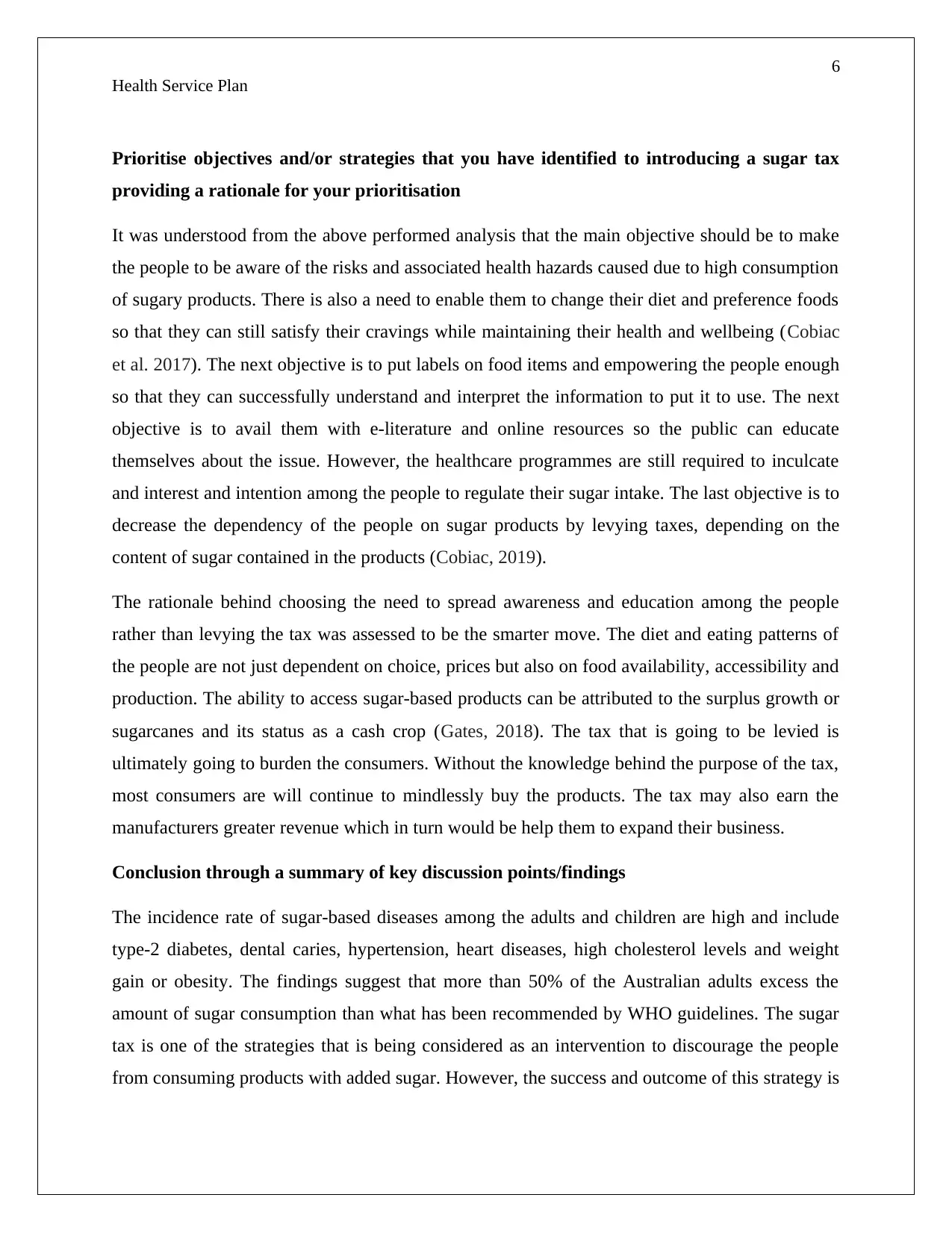
6
Health Service Plan
Prioritise objectives and/or strategies that you have identified to introducing a sugar tax
providing a rationale for your prioritisation
It was understood from the above performed analysis that the main objective should be to make
the people to be aware of the risks and associated health hazards caused due to high consumption
of sugary products. There is also a need to enable them to change their diet and preference foods
so that they can still satisfy their cravings while maintaining their health and wellbeing (Cobiac
et al. 2017). The next objective is to put labels on food items and empowering the people enough
so that they can successfully understand and interpret the information to put it to use. The next
objective is to avail them with e-literature and online resources so the public can educate
themselves about the issue. However, the healthcare programmes are still required to inculcate
and interest and intention among the people to regulate their sugar intake. The last objective is to
decrease the dependency of the people on sugar products by levying taxes, depending on the
content of sugar contained in the products (Cobiac, 2019).
The rationale behind choosing the need to spread awareness and education among the people
rather than levying the tax was assessed to be the smarter move. The diet and eating patterns of
the people are not just dependent on choice, prices but also on food availability, accessibility and
production. The ability to access sugar-based products can be attributed to the surplus growth or
sugarcanes and its status as a cash crop (Gates, 2018). The tax that is going to be levied is
ultimately going to burden the consumers. Without the knowledge behind the purpose of the tax,
most consumers are will continue to mindlessly buy the products. The tax may also earn the
manufacturers greater revenue which in turn would be help them to expand their business.
Conclusion through a summary of key discussion points/findings
The incidence rate of sugar-based diseases among the adults and children are high and include
type-2 diabetes, dental caries, hypertension, heart diseases, high cholesterol levels and weight
gain or obesity. The findings suggest that more than 50% of the Australian adults excess the
amount of sugar consumption than what has been recommended by WHO guidelines. The sugar
tax is one of the strategies that is being considered as an intervention to discourage the people
from consuming products with added sugar. However, the success and outcome of this strategy is
Health Service Plan
Prioritise objectives and/or strategies that you have identified to introducing a sugar tax
providing a rationale for your prioritisation
It was understood from the above performed analysis that the main objective should be to make
the people to be aware of the risks and associated health hazards caused due to high consumption
of sugary products. There is also a need to enable them to change their diet and preference foods
so that they can still satisfy their cravings while maintaining their health and wellbeing (Cobiac
et al. 2017). The next objective is to put labels on food items and empowering the people enough
so that they can successfully understand and interpret the information to put it to use. The next
objective is to avail them with e-literature and online resources so the public can educate
themselves about the issue. However, the healthcare programmes are still required to inculcate
and interest and intention among the people to regulate their sugar intake. The last objective is to
decrease the dependency of the people on sugar products by levying taxes, depending on the
content of sugar contained in the products (Cobiac, 2019).
The rationale behind choosing the need to spread awareness and education among the people
rather than levying the tax was assessed to be the smarter move. The diet and eating patterns of
the people are not just dependent on choice, prices but also on food availability, accessibility and
production. The ability to access sugar-based products can be attributed to the surplus growth or
sugarcanes and its status as a cash crop (Gates, 2018). The tax that is going to be levied is
ultimately going to burden the consumers. Without the knowledge behind the purpose of the tax,
most consumers are will continue to mindlessly buy the products. The tax may also earn the
manufacturers greater revenue which in turn would be help them to expand their business.
Conclusion through a summary of key discussion points/findings
The incidence rate of sugar-based diseases among the adults and children are high and include
type-2 diabetes, dental caries, hypertension, heart diseases, high cholesterol levels and weight
gain or obesity. The findings suggest that more than 50% of the Australian adults excess the
amount of sugar consumption than what has been recommended by WHO guidelines. The sugar
tax is one of the strategies that is being considered as an intervention to discourage the people
from consuming products with added sugar. However, the success and outcome of this strategy is
⊘ This is a preview!⊘
Do you want full access?
Subscribe today to unlock all pages.

Trusted by 1+ million students worldwide
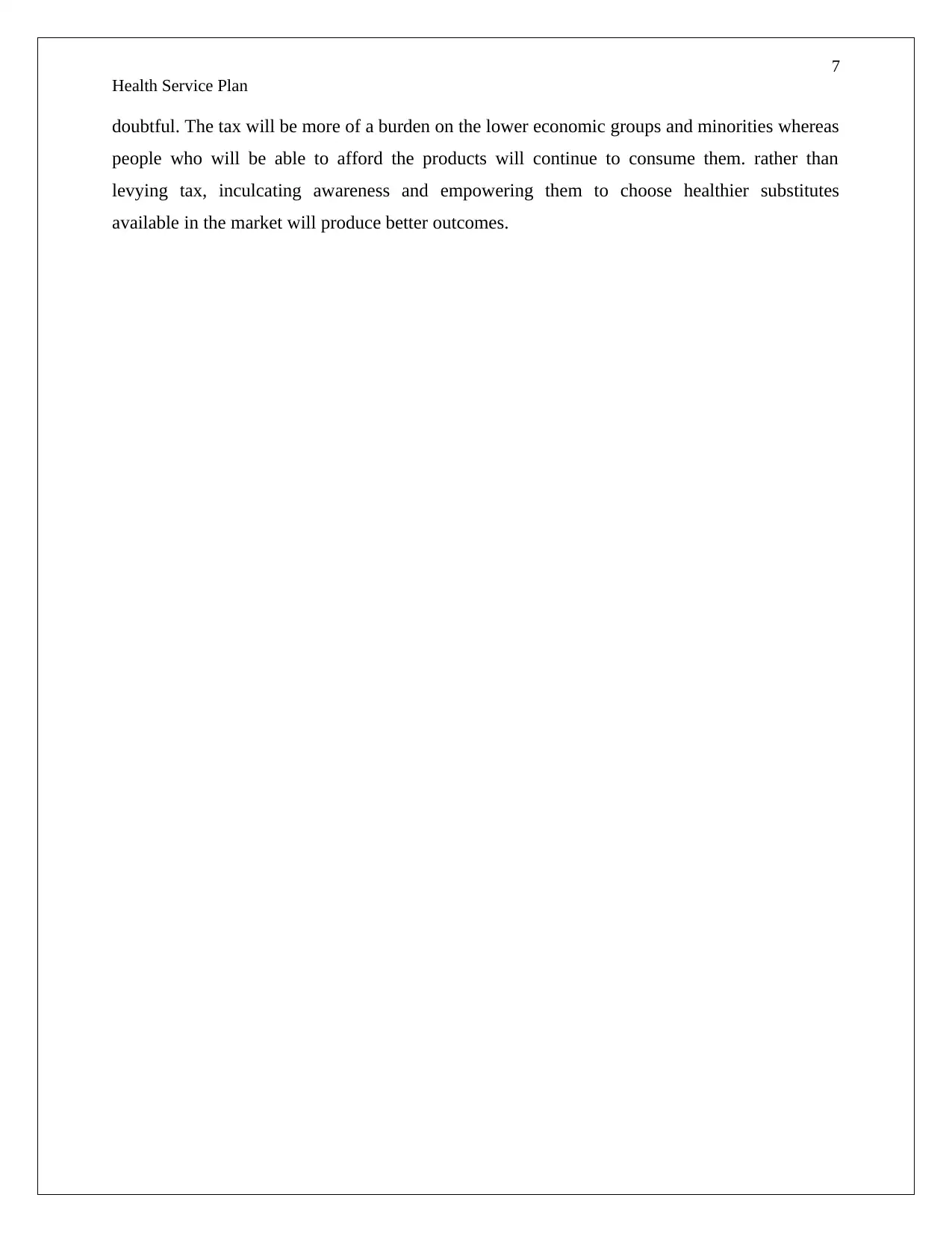
7
Health Service Plan
doubtful. The tax will be more of a burden on the lower economic groups and minorities whereas
people who will be able to afford the products will continue to consume them. rather than
levying tax, inculcating awareness and empowering them to choose healthier substitutes
available in the market will produce better outcomes.
Health Service Plan
doubtful. The tax will be more of a burden on the lower economic groups and minorities whereas
people who will be able to afford the products will continue to consume them. rather than
levying tax, inculcating awareness and empowering them to choose healthier substitutes
available in the market will produce better outcomes.
Paraphrase This Document
Need a fresh take? Get an instant paraphrase of this document with our AI Paraphraser
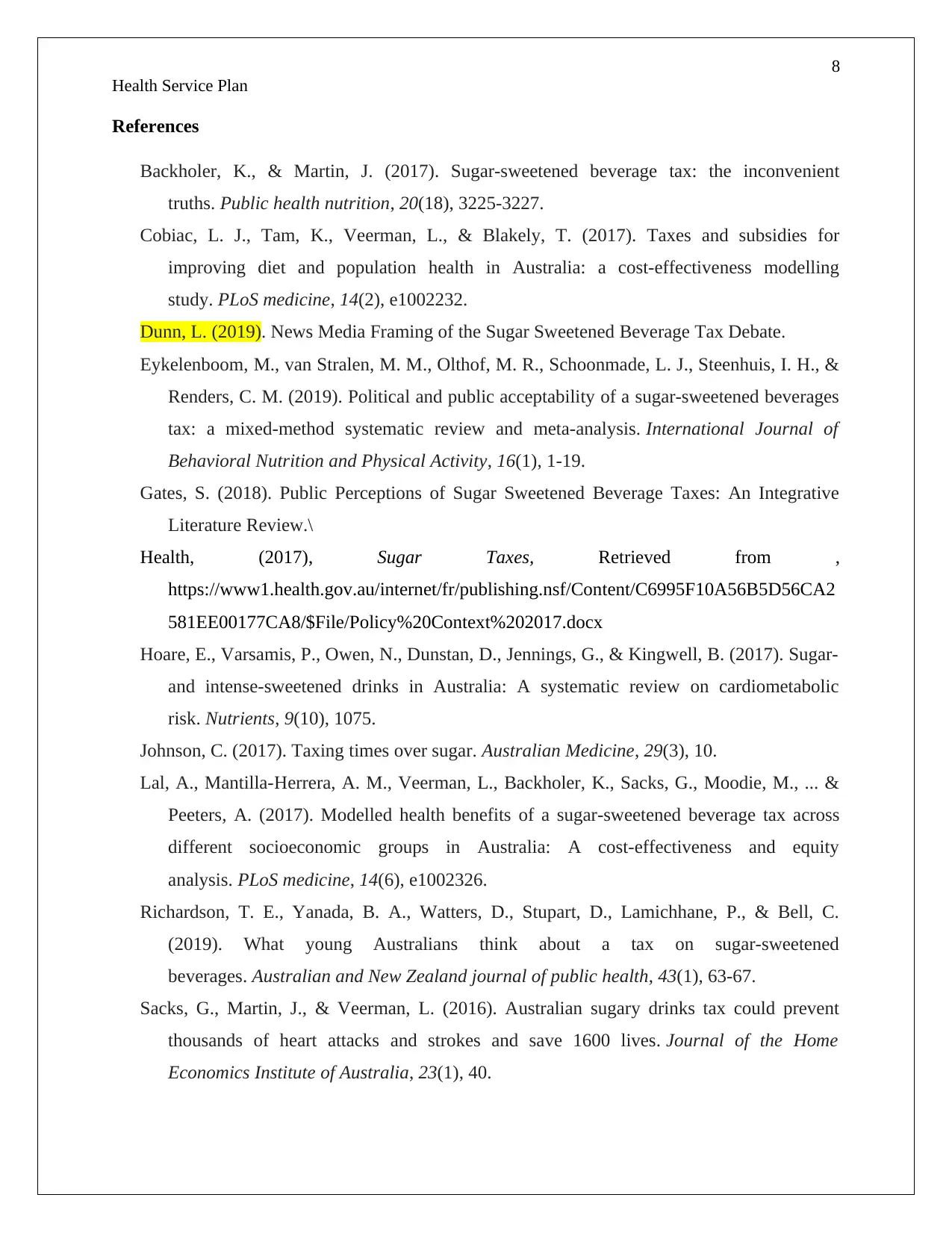
8
Health Service Plan
References
Backholer, K., & Martin, J. (2017). Sugar-sweetened beverage tax: the inconvenient
truths. Public health nutrition, 20(18), 3225-3227.
Cobiac, L. J., Tam, K., Veerman, L., & Blakely, T. (2017). Taxes and subsidies for
improving diet and population health in Australia: a cost-effectiveness modelling
study. PLoS medicine, 14(2), e1002232.
Dunn, L. (2019). News Media Framing of the Sugar Sweetened Beverage Tax Debate.
Eykelenboom, M., van Stralen, M. M., Olthof, M. R., Schoonmade, L. J., Steenhuis, I. H., &
Renders, C. M. (2019). Political and public acceptability of a sugar-sweetened beverages
tax: a mixed-method systematic review and meta-analysis. International Journal of
Behavioral Nutrition and Physical Activity, 16(1), 1-19.
Gates, S. (2018). Public Perceptions of Sugar Sweetened Beverage Taxes: An Integrative
Literature Review.\
Health, (2017), Sugar Taxes, Retrieved from ,
https://www1.health.gov.au/internet/fr/publishing.nsf/Content/C6995F10A56B5D56CA2
581EE00177CA8/$File/Policy%20Context%202017.docx
Hoare, E., Varsamis, P., Owen, N., Dunstan, D., Jennings, G., & Kingwell, B. (2017). Sugar-
and intense-sweetened drinks in Australia: A systematic review on cardiometabolic
risk. Nutrients, 9(10), 1075.
Johnson, C. (2017). Taxing times over sugar. Australian Medicine, 29(3), 10.
Lal, A., Mantilla-Herrera, A. M., Veerman, L., Backholer, K., Sacks, G., Moodie, M., ... &
Peeters, A. (2017). Modelled health benefits of a sugar-sweetened beverage tax across
different socioeconomic groups in Australia: A cost-effectiveness and equity
analysis. PLoS medicine, 14(6), e1002326.
Richardson, T. E., Yanada, B. A., Watters, D., Stupart, D., Lamichhane, P., & Bell, C.
(2019). What young Australians think about a tax on sugar‐sweetened
beverages. Australian and New Zealand journal of public health, 43(1), 63-67.
Sacks, G., Martin, J., & Veerman, L. (2016). Australian sugary drinks tax could prevent
thousands of heart attacks and strokes and save 1600 lives. Journal of the Home
Economics Institute of Australia, 23(1), 40.
Health Service Plan
References
Backholer, K., & Martin, J. (2017). Sugar-sweetened beverage tax: the inconvenient
truths. Public health nutrition, 20(18), 3225-3227.
Cobiac, L. J., Tam, K., Veerman, L., & Blakely, T. (2017). Taxes and subsidies for
improving diet and population health in Australia: a cost-effectiveness modelling
study. PLoS medicine, 14(2), e1002232.
Dunn, L. (2019). News Media Framing of the Sugar Sweetened Beverage Tax Debate.
Eykelenboom, M., van Stralen, M. M., Olthof, M. R., Schoonmade, L. J., Steenhuis, I. H., &
Renders, C. M. (2019). Political and public acceptability of a sugar-sweetened beverages
tax: a mixed-method systematic review and meta-analysis. International Journal of
Behavioral Nutrition and Physical Activity, 16(1), 1-19.
Gates, S. (2018). Public Perceptions of Sugar Sweetened Beverage Taxes: An Integrative
Literature Review.\
Health, (2017), Sugar Taxes, Retrieved from ,
https://www1.health.gov.au/internet/fr/publishing.nsf/Content/C6995F10A56B5D56CA2
581EE00177CA8/$File/Policy%20Context%202017.docx
Hoare, E., Varsamis, P., Owen, N., Dunstan, D., Jennings, G., & Kingwell, B. (2017). Sugar-
and intense-sweetened drinks in Australia: A systematic review on cardiometabolic
risk. Nutrients, 9(10), 1075.
Johnson, C. (2017). Taxing times over sugar. Australian Medicine, 29(3), 10.
Lal, A., Mantilla-Herrera, A. M., Veerman, L., Backholer, K., Sacks, G., Moodie, M., ... &
Peeters, A. (2017). Modelled health benefits of a sugar-sweetened beverage tax across
different socioeconomic groups in Australia: A cost-effectiveness and equity
analysis. PLoS medicine, 14(6), e1002326.
Richardson, T. E., Yanada, B. A., Watters, D., Stupart, D., Lamichhane, P., & Bell, C.
(2019). What young Australians think about a tax on sugar‐sweetened
beverages. Australian and New Zealand journal of public health, 43(1), 63-67.
Sacks, G., Martin, J., & Veerman, L. (2016). Australian sugary drinks tax could prevent
thousands of heart attacks and strokes and save 1600 lives. Journal of the Home
Economics Institute of Australia, 23(1), 40.
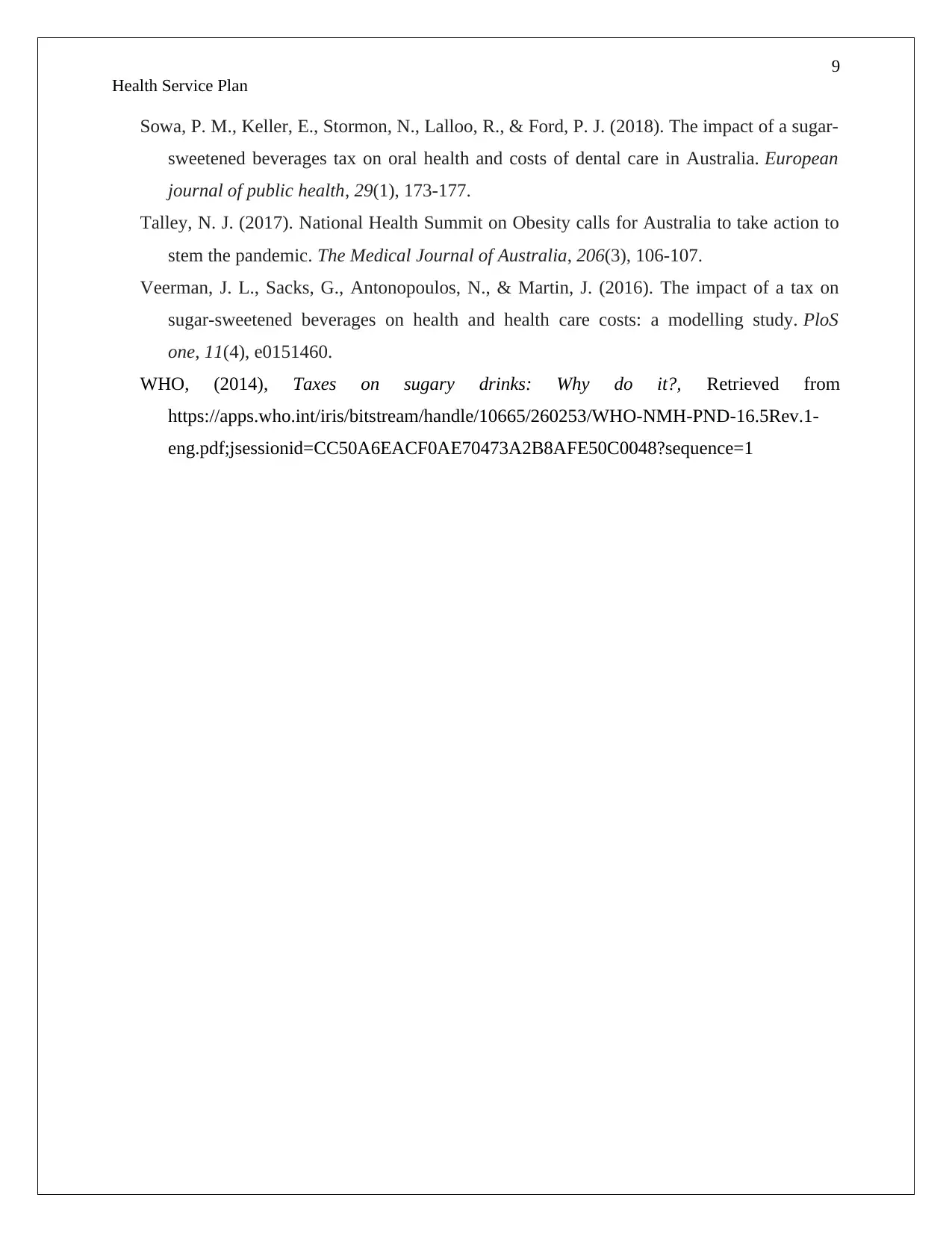
9
Health Service Plan
Sowa, P. M., Keller, E., Stormon, N., Lalloo, R., & Ford, P. J. (2018). The impact of a sugar-
sweetened beverages tax on oral health and costs of dental care in Australia. European
journal of public health, 29(1), 173-177.
Talley, N. J. (2017). National Health Summit on Obesity calls for Australia to take action to
stem the pandemic. The Medical Journal of Australia, 206(3), 106-107.
Veerman, J. L., Sacks, G., Antonopoulos, N., & Martin, J. (2016). The impact of a tax on
sugar-sweetened beverages on health and health care costs: a modelling study. PloS
one, 11(4), e0151460.
WHO, (2014), Taxes on sugary drinks: Why do it?, Retrieved from
https://apps.who.int/iris/bitstream/handle/10665/260253/WHO-NMH-PND-16.5Rev.1-
eng.pdf;jsessionid=CC50A6EACF0AE70473A2B8AFE50C0048?sequence=1
Health Service Plan
Sowa, P. M., Keller, E., Stormon, N., Lalloo, R., & Ford, P. J. (2018). The impact of a sugar-
sweetened beverages tax on oral health and costs of dental care in Australia. European
journal of public health, 29(1), 173-177.
Talley, N. J. (2017). National Health Summit on Obesity calls for Australia to take action to
stem the pandemic. The Medical Journal of Australia, 206(3), 106-107.
Veerman, J. L., Sacks, G., Antonopoulos, N., & Martin, J. (2016). The impact of a tax on
sugar-sweetened beverages on health and health care costs: a modelling study. PloS
one, 11(4), e0151460.
WHO, (2014), Taxes on sugary drinks: Why do it?, Retrieved from
https://apps.who.int/iris/bitstream/handle/10665/260253/WHO-NMH-PND-16.5Rev.1-
eng.pdf;jsessionid=CC50A6EACF0AE70473A2B8AFE50C0048?sequence=1
⊘ This is a preview!⊘
Do you want full access?
Subscribe today to unlock all pages.

Trusted by 1+ million students worldwide
1 out of 9
Related Documents
Your All-in-One AI-Powered Toolkit for Academic Success.
+13062052269
info@desklib.com
Available 24*7 on WhatsApp / Email
![[object Object]](/_next/static/media/star-bottom.7253800d.svg)
Unlock your academic potential
Copyright © 2020–2025 A2Z Services. All Rights Reserved. Developed and managed by ZUCOL.





